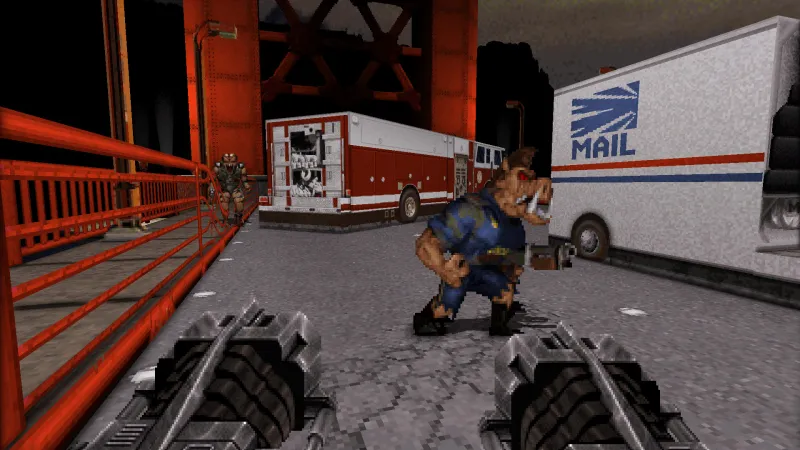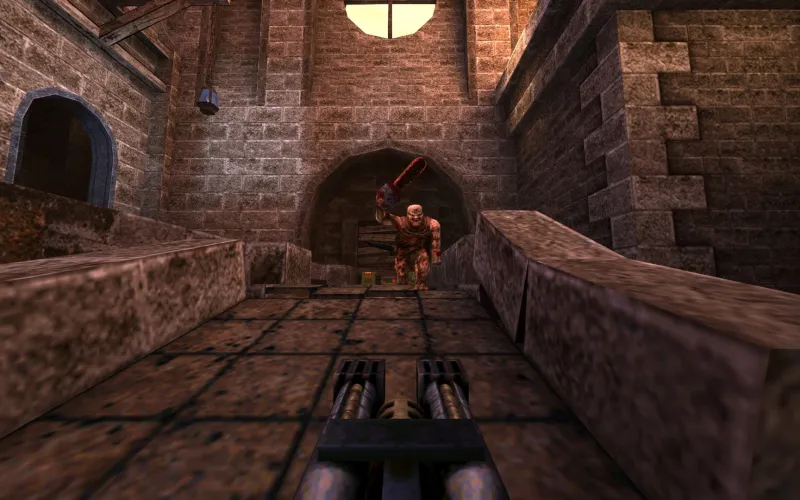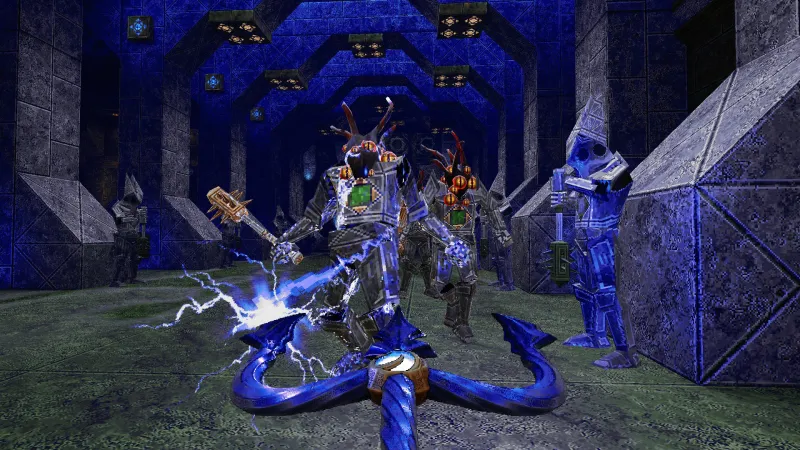You are a banshee of speed, a spark crawling its way up a fuse, a disaster waiting to happen. Until –
A scarecrow makes the mistake of turning into a man right before you, a shotgun-toting farmer with the barrel pointed at your face. You greet him with your own shotgun, double-barreled, finger on the trigger.
You eclipse him in a bear hug of bullets and sound. Above you, the sky – already the hue of a bloodhound’s fever dream – is somehow even redder. One moment later, and you’re already gone.
This is Dusk, one of a handful of recent games harkening back to the Doom and Quake era and the invention of the FPS genre itself. Over the past few years, “boomer shooters” like Dusk, Amid Evil, and Ultrakill have awakened a hunger long thought dormant, and publisher New Blood Interactive is on a mission to ensure we remain well-fed.
Knee-Deep In The Dead
In 1993, a shotgun blast thundered throughout millions of American bedrooms. It echoed across college dormitories and office cubicles, casting firework bursts of light onto the faces of whoever witnessed it.
The blast was so powerful it survived a journey across the globe and back, withstanding entire generations without fading away. It afflicted any who heard it with a strange sickness: The fanatical desire to bully digital devils into piles of bloody gibs (i.e., pulpy chunks of gore).
In short, they discovered Doom.

The original Doom, released in 1993
In Doom, the player is a space marine barreling through military bases and eventually into Hell itself, laying waste to rooms of demon invaders. It’s still revered as a towering monument to video game violence.
Id Software, Doom’s developer, had found earlier success with 1992’s Wolfenstein 3D, a game that synthesized 3D graphics with fast, first-person action gameplay. Together with Doom, they helped shape the FPS genre and kickstart a PC gaming revolution.
Not only is Doom’s engine the basis for countless user-made WADs – Doom lingo for “mods” – but it also serves as the foundation for Raven Software’s Heretic (1994) and Hexen (1995). These games swap Doom’s sci-fi for dark fantasy, arming the player with flails and scepters instead of guns.
Such was the era of the “Doom clone.” The studio Apogee – now 3D Realms – followed up Rise of the Triad: Dark War (1995) with Duke Nukem 3D (1996), a game now notorious for its hyperbolic “dudebro” humor. Other Doom clones include Star Wars: Dark Forces (1995), Blood (1997), and Shadow Warrior (1997).

Duke Nukem 3D
On a mechanical level, these games are united by high movement speeds, labyrinthine levels, and level “scores” measuring completion times and percentages (e.g., how many enemies or secrets the player found). Aesthetic similarities include slasher-movie bloodiness and animations that render enemies into supernovas of gibs.
After 1994’s Doom II, Id Software broke new ground again with Quake in 1996, introducing “true 3D” levels with vertical camera movements and the “deathmatch.” 1997’s Quake II introduced animated cutscenes and more comprehensive lighting effects; dim hallways turned bullets into kamikaze fireflies.
For a moment in the ’90s, it felt like Doom clutched the very future in its claws. But over the next two decades, the FPS genre reinvented itself many times over to accommodate the trends of the growing industry. The era of the Doom clone faded away – until recently.
By the time New Blood released David Szymanski’s Dusk in 2018, it had been exactly 25 years since Doom first gripped the world with its fury. The same year, New Blood released Indefatigable’s Amid Evil. In both games, Doom and Quake are evident as influences from the moment you train your weapon on your first bloodthirsty freak.
But these games aren’t Doom clones: they are boomer shooters.
Dimension Of The Doomed
First, the obvious. Why “boomer shooter”? Accor- ding to the dates above, most members of the original Doom clone audience would be Gen X’ers.
Szymanski says that the anachronism in calling themselves “boomers” was always part of the joke. “We’re the out-of-touch boomer dad mowing our lawns, drinking Monster Energy, and talking about how awesome Quake was,” he says. Yet the term also alludes to the genuine longing that prompted developers like him to reevaluate the history of the FPS genre itself.
In Szymanski’s opinion, signs of the changing times were evident by the mid-2000s. “It’s before stuff got really cutscene-heavy and ‘hand-holdy’ and stuff like that,” he says.

Quake
Szymanski, who grew up in rural Pennsylvania in a house swallowed by trees, could only experience the genre’s evolution vicariously. In early adolescence, he’d cultivated a love for shooters after discovering Chasm: The Rift – a lesser-known shooter from the Quake days – on a shareware disc.
But the hardware in his family’s computer regularly failed to meet the requirements of then-modern games, which were becoming more demanding as graphics advanced. Instead, he frequented the local library to use its internet, gleaning as much information as possible about the latest FPS titles.
“2004 was a mini-golden age of FPSs,” Szymanski says. “Before stuff went the way of the linear cinematic shooter […] that was really when that formula was at its best.” That year marked the release of three landmark FPS titles: Halo 2, Half-Life 2, and Doom 3, each alluding to new futures for the genre.
Though he’d harbored a quiet longing to play Doom 3 himself, Szymanski was content to play the first Doom, the first Quake, and other ’90s shooters like Chasm, laying the foundation for his fascination with the era.
Icon Of Sin
Meanwhile, as the FPS genre continued shifting, so did the game industry. Dave Oshry, one of New Blood’s co-founders, witnessed this first-hand. “PC gaming was very dead for, like, 10 years,” Oshry says. “It was not the ’90s anymore.”
Id Software’s John Carmack once famously compared stories in games to stories in porn, arguing that narrative is unimportant in either context. History, however, proved him wrong.
For example, 2007’s Call of Duty 4: Modern Warfare represented a watershed moment. In addition to foretelling the industry’s fixation on militaristic settings, COD 4 contained the series’ most ambitious single-player campaign to date, shifting perspectives between characters of various backgrounds as they navigated a global nuclear conflict.
By the early 2010s, TV critics had begun using the term “prestige TV” to describe shows that were considered on par with film in artistry; soon, the idea of a “prestige game” emerged, too. 2013 alone had The Last of Us, Bioshock Infinite, and Grand Theft Auto V – big-budget epics rich with detail.
That same year, Oshry was one of the people at the helm of a project with much different aspirations. He’d joined a studio called Interceptor Entertainment – now Slipgate Ironworks – to direct a remake of Rise of the Triad.
The ROTT team included Leon Zawada and Simon Rance, childhood friends who later formed the studio Indefatigable. Though this was their first professional experience in game development, the two shared a storied history of designing WADs together, swapping turns at Rance’s PC as children.

Dusk
“My uncle had a copy of Doom II and used to make maps for it – specifically, multiplayer maps,” Zawada says. “It was such a revelation that you could make these 3D worlds.”
After ROTT was released in 2013, Oshry, Zawada, and Rance each left Interceptor to pursue other projects. Empowered by their stint in a professional environment, Zawada and Rance began working on their own game. Though Doom and Quake were primary inspirations for level design and game feel, Heretic and Hexen influenced the game’s visual identity and arsenal of magic-infused weapons.
Oshry, on the other hand, founded New Blood with some friends. They spent a few years developing VR games before pivoting into indie publishing, but Oshry still hadn’t felt that they’d found their voice.
Suddenly, in 2016, Oshry got a Twitter DM that changed everything. “This random guy’s like, ‘Hey, do you want to check out my game?’” Oshry recalls.
That person was David Szymanski, who’d discovered Oshry through 2013’s ROTT. He’d developed a taste for horror films in college, and The Texas Chainsaw Massacre, with its sepia-tinted visions of a remote domicile in decay, resonated with the horror he’d known from his youth: the darkness buried in the thicket, singing from the heart of the woods outside his home. He’d channeled these experiences into developing an FPS called Dusk.
Oshry opened up Dusk’s demo and was floored. “You know, everything that people love Dusk for was all in this tiny little demo,” Oshry says. “There was something special about the way this guy worked.”
He responded to Szymanski with an offer to publish Dusk through New Blood. Indefatigable got in touch shortly after, and Amid Evil joined the roster.
“The rest is history,” Oshry says.
The Realm Of Black Magic
What Oshry saw in both Dusk and Amid Evil is what binds boomer shooters together; it’s a mutation of the Doom clone DNA that unites demon slayers from then and now. Outside of New Blood, the boomer shooter label also applies to Ion Fury, Turbo Overkill, Prodeus, and other FPS games that are otherwise “retro.” Though these games may differ in presentation and mechanics, their similarities are primarily experiential.
In essence, boomer shooters inspire three distinct feelings:
- a devotional love of the shotgun
- an unforgiving need for speed
- an archaeologist’s fetish for secrets
The first need not be literal; neither Hexen nor Amid Evil features a shotgun in their arsenals, after all. In this case, the shotgun is a symbol: the knee that jerks when the lights come on in a crowded room full of enemies, an extension of your id itself. The shotgun’s syncopated, start-stop rhythm demands constant movement, coaxing you to waltz through the open spaces in a hail of bullets.

Amid Evil
Indefatigable designed Amid Evil around this feeling, inspired by the way Hexen and Heretic empowered magic users. “It always sucks when you play a game as a mage, and the mage is really weak,” Zawada says.
“Yeah, exactly,” Rance agrees. “It’s magic.”
Secrets are sacrosanct, too. Unlike Wolfenstein 3D, Doom contains levels full of complex polygons stacked into architectural oddities. This allowed level designers to tuck hidden items into the negative space around major set pieces.
Hidden doors and passages remain a prominent feature of boomer shooters, training players to become scholars of level design. Some secrets function as punchlines; in one of Amid Evil’s secret rooms, for example, the words “El Zee wuz here” (as in “LZ,” Leon Zawada’s initials) are scrawled crudely across the wall.
This is the design language of boomer shooters, and it’s the reason they’re easily identifiable regardless of a game’s setting or visual aesthetic.
The question, however, remains: Why did boomer shooters emerge when they did? What happened between the ’90s and now?
No Rest For The Living
One answer is that Dusk and Amid Evil stood in stark contrast to the other games taking the world by storm at the time.
2018 was the year of the battle royale, and players rushed to cram themselves into the hundred-person arenas found in games like PlayerUnknown’s Battlegrounds and Fortnite. Single-player titles, on the other hand, remained committed to “prestige”-grade storytelling. The God of War reboot reimagined protagonist Kratos with newfound depth and maturity; Red Dead Redemption 2 reportedly spans 2,000 pages of dialogue. Dusk and Amid Evil are more intimate and self-contained experiences, by comparison, evoking a past without online matchmaking or pre-rendered 3D cutscenes.
Yet boomer shooters don’t dwell too much on the past. Dusk and Amid Evil are more than modern WADs; they identify the “Doom clone” as its own form distinct from other shooters, adhering to its limitations while entertaining new possibilities. Both strive for more than homage, instead providing glimpses into an alternate reality in which the “Doom clone” had become enshrined more formally as its own genre – even as hardware evolved.

Ultrakill
Ultrakill, a New Blood-published game developed by Finnish developer Hakita, exemplifies this. It finds common ground between bloody boomer shooter mania and the acrobatic character action gameplay of Capcom titles like Devil May Cry 3. The FPS elements, however, weren’t always a part of the equation.
“After I played Dusk, I started visiting and revisiting those classic FPS games and started noticing the surprising amount of overlap […] between them and character action games,” Hakita says.
This shared ground is what allows games like Dusk, Amid Evil, and Ultrakill to cohabit within the same genre. Their common denominators are primarily experiential, enabling bolder interpretations of the “Doom clone” form.
Additionally, boomer shooters anticipate the shifts that have occurred across the gaming medium over the past couple of decades. For example, when Quake was first released, many players completed the game using only a keyboard. By contrast, Ultrakill’s blistering speeds all but demand that the player use a mouse or thumbstick to aim, a method that results in more precision.
Overall, the boomer shooter movement has resulted in more than a few well-executed explorations within an older form; it’s encouraged a newfound curiosity in reevaluating groundbreaking games from the past, charting possible futures for ideas that might have only been realized across a small handful of titles.
This perspective is anything but regressive. It’s imaginative and transformative, becoming increasingly important as a listless yet all-encompassing nostalgia continues to grip the greater media landscape beyond games.
The future looks a bit brighter, and only time will tell what new games and sub-genres will emerge. Until then, the shotgun’s loaded, and there’s a roomful of bloodthirsty devil-horned creeps just around the corner.
This piece was originally published in Game Informer issue 360
